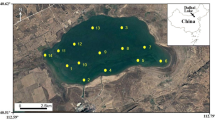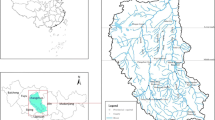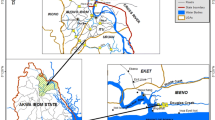Abstract
The distribution and potential toxicity of polycyclic aromatic hydrocarbons (PAHs) in the sediments of Liaohe River Basin were investigated in this study. Total concentrations of 16 PAHs (∑PAH16) ranged from 82.5 to 25374.4 μg/kg averaging 3149.2 μg/kg. Three predominant PAHs were fluoranthene, phenanthrene, and pyrene. In Liao River, two-to-three-ring PAHs were dominant taking up 67.2–92.5 % of ∑PAH16, whereas sediments in Daliao River system mainly contained four-to-six-ring PAHs ranging from 47.8 to 83.7 %. Both petrogenic and pyrogenic sources contributed to the PAH pollution based on diagnostic ratios. The empirical and mechanistic sediment quality guidelines were used to estimate the toxicity risk of PAHs to benthic organisms. The ∑PAH16 in all sediments were significantly lower than probable effect concentrations (PEC), while ∑PAH16 at nine sites of the Daliao River system were between threshold effect concentrations (TEC) and PEC, suggesting that adverse effects were possible at the nine sites. The only individual PAH was acenaphthene whose concentrations were above PEC at some sites, indicating its potential toxicity. Based upon equilibrium partitioning theory and narcosis model, the obtained toxic units for PAH mixtures at all sites were far less than one, implying that the levels of PAH mixtures were acceptable for the protection of benthic fauna. The two evaluation methods lead to the consistent results that benthic organisms inhabiting in the sediments of Liaohe River Basin have no or low risk of adverse effects resulting from exposure to PAHs.




Similar content being viewed by others
References
Baumard, P., Budzinski, H., & Garrigues, P. (1998). Polycyclic aromatic hydrocarbons in sediments and mussels of the western Mediterranean Sea. Environmental Toxicology and Chemistry, 17, 765–776.
Burgess, R. M., Berry, W. J., Mount, D. R., & Di Toro, D. M. (2013). Mechanistic sediment quality guidelines based on contaminant bioavailability: equilibrium partitioning sediment benchmarks. Environmental Toxicology and Chemistry, 32, 102–114.
CCME. (2002). Canadian sediment quality guidelines for the protection of aquatic life: summary tables. updated. In Canadian environmental quality guidelines, 1999. Winnipeg: Canadian Council of Ministers of the Environment.
Di Toro, D. M., & McGrath, J. A. (2000). Technical basis for narcotic chemicals and polycyclic aromatic hydrocarbon criteria. II. Mixtures and sediments. Environmental Toxicology and Chemistry, 19, 1971–1982.
Di Toro, D. M., Zarba, C. S., Hansen, D. J., Berry, W. J., Swartz, R. C., Cowan, C. E., Pavlou, S. P., Allen, H. E., Thomas, N. A., & Paquin, P. R. (1991). Technical basis for the equilibrium partitioning method for establishing sediment quality criteria. Environmental Toxicology and Chemistry, 11, 1541–1583.
Di Toro, D. M., Berry, W. J., Burgess, R. M., Mount, D. R., O’connor, T. P., & Swartz, R. C. (2005). The predictive ability of sediment quality guidelines derived using equilibrium partitioning (Use of sediment quality guidelines and related tools for the assessment of contaminated sediments).
Feng, C. L., Xia, X. H., Shen, Z. Y., & Zhou, Z. (2007). Distribution and sources of polycyclic aromatic hydrocarbons in Wuhan section of the Yangtze River, China. Environmental Monitoring and Assessment, 133, 447–458.
Fu, J., Ding, Y. H., Li, L., Sheng, S., Wen, T., Yu, L. J., Chen, W., An, S. Q., & Zhu, H. L. (2011). Polycyclic aromatic hydrocarbons and ecotoxicological characterization of sediments from the Huaihe River, China. Journal of Environmental Monitoring, 13, 597–604.
GAQS-IQ (General Administration of Quality Supervision, Inspection and Quarantine of the People’s Republic of China). (2008). The speciation for marine monitoring- Part 5: Sediment analysis. Beijing: 50–52.
Guo, W., He, M. C., Yang, Z. F., Lin, C. Y., Quan, X. C., & Wang, H. Z. (2007). Distribution of polycyclic aromatic hydrocarbons in water, suspended particulate matter and sediment from Daliao River watershed, China. Chemosphere, 68, 93–104.
Hawthorne, S. B., Miller, D. J., & Kreitinger, J. P. (2006). Measurement of total polycyclic aromatic hydrocarbon concentrations in sediments and toxic units used for estimating risk to benthic invertebrates at manufactured gas plant sites. Environmental Toxicology and Chemistry, 25, 287–296.
Hu, N. J., Shi, X. F., Liu, J. H., Huang, P., Liu, Y. G., & Liu, Y. (2010). Concentrations and possible sources of PAHs in sediments from Bohai Bay and adjacent shelf. Environmental Earth Sciences, 60, 1771–1782.
Kannan, K., Johnson-Restrepo, B., Yohn, S. S., Giesy, J. P., & Long, D. T. (2005). Spatial and temporal distribution of polycyclic aromatic hydrocarbons in sediments from Michigan inland lakes. Environmental Science and Technology, 39, 4700–4706.
Li, J. F., Dong, H., Zhang, D. H., Han, B., Zhu, C. J., Liu, S. P., Liu, X. M., Ma, Q. Y., & Li, X. G. (2015). Sources and ecological risk assessment of PAHs in surface sediments from Bohai Sea and northern part of the Yellow Sea, China. Marine Pollution Bulletin. doi:10.1016/j.marpolbul.2015.05.002.
Liu, Y., Ling, C. N., Zhao, J. F., Huang, Q. H., Zhu, Z. L., & Gao, H. W. (2008). Distribution and sources of polycyclic aromatic hydrocarbons in surface sediments of rivers and an estuary in Shanghai, China. Environmental Pollution, 54, 298–305.
Lv, J. P., Xu, J., Guo, C. S., Zhang, Y., Bai, Y. W., & Meng, W. (2014). Spatial and temporal distribution of polycyclic aromatic hydrocarbons (PAHs) in surface water from Liaohe River Basin, northeast China. Environmental Science and Pollution Research, 21, 7088–7096.
MacDonald, D. D., Dipinto, L. M., Field, J., Ingersoll, C. G., Lvong, E. R., & Swartz, R. C. (2000a). Development and evaluation of consensus-based sediment effect concentrations for polychlorinated biphenyls. Environmental Toxicology and Chemistry, 19, 1403–1413.
MacDonald, D. D., Ingersoll, C. G., & Berger, T. A. (2000b). Development and evaluation of consensus-based sediment quality guidelines for freshwater ecosystems. Archives of Environment Contamination and Toxicology, 39, 20–31.
Mai, B. X., Fu, H. M., Sheng, G. Y., Kang, Y. H., Lin, Z., Zhang, G., Min, Y. S., & Zeng, E. Y. (2002). Chlorinated and polycyclic aromatic hydrocarbons in riverine and estuarine sediments from Pearl River Delta, China. Environmental Pollution, 117, 457–474.
Mastral, A. M., & Callen, M. S. (2000). A review on polycyclic aromatic hydrocarbon (PAH) emissions from energy generation. Environmental Science and Technology, 34, 3051–3057.
Ololade, I. A. (2010). Prediction of polycyclic aromatic hydrocarbons toxicity using equilibrium partitioning approach and narcosis model. Bulletin of Environment Contamination and Toxicology, 85, 238–242.
Persaud, D., Jaagumagi, R., & Hayton, A. (1993). Guidelines for the protection and management of aquatic sediment quality in Ontario: Report. Water Resources Branch, Ontario Ministry of the Environment.
Pothuluri, J. V., Freeman, J. P., Evans, F. E., & Cerniglia, C. E. (1992). Fungal metabolism of acenaphthene by Cunninghamella elegans. Applied and Environment Microbiology, 58, 3654–3659.
Shi, Z., Tao, S., Pan, B., Fan, W., He, X. C., Zuo, Q., Wu, S. P., Li, B. G., Cao, J., Liu, W. X., Xu, F. L., Wang, X. J., Shen, W. R., & Wong, P. K. (2005). Contamination of rivers in Tianjin, China by polycyclic aromatic hydrocarbons. Environmental Pollution, 134, 97–111.
Swartz, R. C. (1999). Consensus sediment quality guidelines for polycyclic aromatic hydrocarbon mixtures. Environmental Toxicology and Chemistry, 18, 780–787.
USEPA. (2003). Procedures for the derivation of equilibrium partitioning sediment benchmarks (ESBs) for the protection of benthic organisms: PAH mixtures, EPA-600-R-02-13, Washington, DC 20460: United States Environmental Protection Agency, Office of Research and Development.
Verhaar, H. J. M., Van Leeuwen, C. J., & Hermens, J. L. M. (1992). Classifying environmental pollutants. Chemosphere, 25, 471–491.
Veses, O., Mosteo, R., Ormad, M. P., & Ovelleiro, J. L. (2012). Potential toxicity of polycyclic aromatic hydrocarbons and organochlorine pesticides in sediments from the Ebro River Basin in Spain. Bulletin of Environment Contamination and Toxicology, 88, 644–650.
Weinstein, J. E., Crawford, K. D., Garner, T. R., & Flemming, A. J. (2010). Screening-level ecological and human health risk assessment of polycyclic aromatic hydrocarbons in stormwater detention pond sediments of Coastal South Carolina, USA. Journal of Hazardous Materials, 178, 906–916.
Wilcke, W., & Amelung, W. (2000). Persistent organic pollutants in native grassland soils along a climosequence in North America. Soil Science Society of America Journal, 64, 2140–2148.
Xu, J., Yu, Y., Wang, P., Guo, W. F., Dai, S. G., & Sun, H. W. (2007). Polycyclic aromatic hydrocarbons in the surface sediments from Yellow River, China. Chemosphere, 67, 1408–1414.
Zakaria, M. P., Takada, H., Tsutsumi, S., Ohno, K., Yamada, J., Kouno, E., & Kumata, H. (2002). Distribution of polycyclic aromatic hydrocarbons (PAHs) in rivers and estuaries in Malaysia: a widespread input of petrogenic PAHs. Environmental Science and Technology, 36, 1907–1918.
Zhang, Z. L., Huang, J., Yu, G., & Hong, H. S. (2004). Occurrence of PAHs, PCBs and organochlorine pesticides in the Tonghui River of Beijing, China. Environmental Pollution, 130, 249–261.
Zhang, H. L., Sun, L. N., Sun, T. H., Li, H. Y., & Luo, Q. (2013a). Spatial distribution and seasonal variation of polycyclic aromatic hydrocarbons (PAHs) contaminations in surface water from the Hun River, Northeast China. Environmental Monitoring and Assessment, 185, 1451–1462.
Zhang, L., Qin, Y. W., Zheng, B. H., Lin, T., & Li, Y. Y. (2013b) Polycyclic aromatic hydrocarbons in the sediments of Xiangjiang River in south-central China: occurrence and sources. Environmental Earth Sciences, 69, 119–125.
Zhao, X., Ding, J., & You, H. (2014). Spatial distribution and temporal trends of polycyclic aromatic hydrocarbons (PAHs) in water and sediment from Songhua River, China. Environmental Geochemistry and Health, 36, 131–143.
Acknowledgments
This work was financially supported by the Major Science and Technology Program for Water Pollution Control and Treatment (2012ZX07501-001) and the National Science Foundation of China (51178438).
Author information
Authors and Affiliations
Corresponding author
Rights and permissions
About this article
Cite this article
He, Y., Meng, W., Xu, J. et al. Spatial distribution and potential toxicity of polycyclic aromatic hydrocarbons in sediments from Liaohe River Basin, China. Environ Monit Assess 188, 193 (2016). https://doi.org/10.1007/s10661-016-5201-y
Received:
Accepted:
Published:
DOI: https://doi.org/10.1007/s10661-016-5201-y




